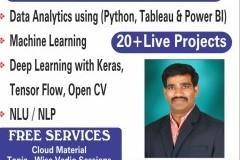Certified Data Science & Analytics Engineer
Key Highlights
Course Includes
1- Introduction to Data Science
Data Science
2- Introduction to Statistics
- Introduction
- Basic Statistics
- Useful statistics in Analytics & Data Science
- Central Tendency
- Normal Distribution
- Hypothesis Testing
R Programming for Data Science & Analytics
Introduction to R
- Math, Variables, and Strings
- Vectors and Factors
- Vector operations
Data structures in R
- Arrays & Matrices
- Lists
- Data frames
R programming fundamentals
- Conditions and loops
- Functions in R
- Objects and Classes
- Debugging
Working with data in R
- Reading CSV and Excel Files
- Reading text files
- Writing and saving data objects to file in R
Strings and Dates in R
- String operations in R
- Regular Expressions
- Dates in R
Python Programming for Data Science
Introduction to Python
- Python History
- Python Applications
- Python Install, Python Path
- Python Example, Execute Python
Datatypes, declarations and comments
- Python Variables and Data Types
- Python Keywords
- Python Literals, Python Comments
- Sample Programs for the above
- Arithmetical Operators
- Relational Operators
- Logical Operators
- Assignment operators
- Sample programs for the above
Conditional Statements
- Simple IF, If and Else, Nested If
- Sample program using if conditions
Python Loops
- Python for loop, Python while loop
Python Loops
- Python break, Python continue, Python pass
Python Data Structures or Collections
- Lists
- Tuples
- Named Tuple
- Sets (Default set, Frozen Set, Union, Intersect, Minus)
Dictionaries
- Un-ordered Dictionary
- Ordered Dictionary
- ChainMap
- Counter
Python String handling and functions
- Handling string format with f-string
- capitalize(),center(),count(),endswith(),format(),rjust(), ljust()
- len(),replace(),upper(),lower(),split()with Examples
Number functions
- abs() ,ceil(), floor(), cmp(), exp(), log(), log10()
- min(), max(), power(), round(), sqrt()With Examples
Date Functions
- import datetime module
- now(),datetime()
- import calendar
- calender.month(),calendar.prcal(2019)
- import time
User defined functions in Python
- required argument function
- keyword argument function
- varying argument Functions
- Default argument functions
- Position only parameter functions
File Handling in Python
- Python Files I/O
- create file using “r”, “w” ,”a” modes
Machine Learning for Data Science
Machine Learning For Data Science & Analytics
Machine learning vs. Statistical modelling
Supervised vs. Unsupervised Learning
- Machine Learning Languages, Types, and Examples
- Machine Learning vs Statistical Modelling
- Supervised vs Unsupervised Learning
- Supervised Learning Classification
- Unsupervised Learning
Supervised Learning
- Understanding nearest neighbour classification
- The KNN algorithm
- Measuring similarity with distance
- Choosing Appropriate K
- Use Case
Classification Using Naïve Bayes
- Basic Concepts of Bayesian Methods
- Probabilistic Learning
Classification using Decision Trees
- The C5.0 decision tree algorithm
- Understanding Classification Rules
- Separate and Conquer
- Rules from decision trees
- Advantages & Disadvantages of Decision Trees
Understanding Regression
- Simple Linear Regression
- Ordinary least Square estimation
Correlations
Multiple Linear Regression
Support Vector Machines
- Classification with Hyper planes
- Using Kernels for non-linear spaces
Unsupervised Learning
Association Rules – Pattern detection
- K-Means Clustering plus Advantages & Disadvantages
- Hierarchical Clustering plus Advantages & Disadvantages
- Measuring the Distances Between Clusters – Single Linkage Clustering
- Measuring the Distances Between Clusters – Algorithms for Hierarchy Clustering
- Density-Based Clustering
Neural Networks
- Black Box Methods
- Training neural networks with backpropagation
- ANN – Artificial Neural Networks
- CNN – Convolutional Neural Networks
Evaluating Model Performance
Improving Model Performance
Data Visualization with Tableau
Customizing a Data Source
- Filtering Your Data
- Sorting Your Data
- Creating Groups in Your Data
- Creating Hierarchies in Your Data
- Working with Date Fields: Discrete and Continuous Time
- Working with Date Fields: Custom Dates
- Working with Multiple Measures: Dual Axis and Combo Charts
- Working with Multiple Measures: Combined Axis Charts
- Showing Relationships between Numerical Values
- Mapping Data Geographically
- Using Crosstabs: Totals and Aggregation
Using Crosstabs: Highlight Tables
- Using Crosstabs: Heat Maps
- Using Calculations: Customize Your Data
- Using Calculations: Working with Strings, Dates, and Type Conversion Functions
- Using Calculations: Working with Aggregations
- Using Quick Table Calculations to Analyze Data
- Showing Breakdowns of the Whole
- Highlighting Data with Reference Lines
- Create a Dashboard: Combining Your Views
- Create a Dashboard: Add Actions for Interactivity
- Sharing Your Work
Working with a Data Extract
- Joining Tables
- Blending Multiple Data Sources
- Blending Data without a Common Field
- Using Split and Custom Split
- Advanced Calculations: Aggregating
Dimensions
- Controlling Table Calculations
- Showing the Biggest and Smallest Values
- Using Level of Detail Expressions
- Filtering and LOD Expressions
- Using Parameters to Control Data in the View
- Parameters: Swap Measures
Using Sets to Highlight Data
- Advanced Mapping: Modifying Locations
- Advanced Mapping: Customizing Tableau’s Geocoding
- Advanced Mapping: Using a Background Image
- Viewing Distributions
- Comparing Measures Against a Goal
- Showing Statistics and Forecasting: Use the Analytics Pane and Trend Lines Advanced
Dashboards: Using Design Techniques and Filter Actions
Telling Stories with Data
Artificial Intelligence for Everyone (AI)
What is AI Applications and Examples of AI
Data
Machine learning
what makes an AI organizations
Workflow of Machine learning project
Workflow of Data Science project
What machine learning can do and cannot do
The Future with AI, and AI in action
The Journey for adopting AI successfully
Career in AI
Technical Tools for AI team
Pytorch,Keras,Scikit-learn,R or Weka
Machine learning opensource frameworks















